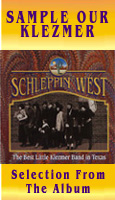

YIDDISH VOCABULARY 101
AY-YAY-YAY -1. Pleasure 2. Regret 3. Congratulations 4. Astonishment 5. Scorn (all depending on facial expression)
BIM-BOM - A charming, meaningless hum (in a song, tale, or monologue)
GEVALT! - Exclamation of fear, astonishment
GEZUNTHAYT - Go in health!
KHAZER - A pig, a glutton, a cheap, selfish person
KLUTZ - A blockhead, a graceless bungler, an insensitive dod
L'CHAYIM - A toast "to life"
MAVEN - An expert
MEGILLA - Any long, boring rigmarole; the same old story or excuse
MESHUGGE - Crazy, obsessed, maddened by a phobia, bizarre
MISHPOCHE - The whole family, including the most remote kin
NEBECH - A weak sister, a born loser
NU? - Quintessential Yiddish emphasizer, qualifier, lament, expletive
SHNOOK - A timid, unassertive sap
SHLEMIL - A simpleton, an unlucky person, a clumsy type, a social misfit
SHLOCK - Shoddy, cheap, a fake article
SHMALTZ - German - "chicken fat" Yiddish - greatly exaggerated
SHMO - A fool
SHMOOS - Friendly chitchat
SHTUNK - An ungrateful person
SCHLEP - To drag, pull, or lag behind
ZAFTIK zaf/-tik- juicy, plump, buxom, well-rounded
KLEZMER is the Yiddish pronunciation of the Hebrew KLEY-Z'MER, (lit.; vessel-of-song)-"musical instrument"-which, in the East European context, came to refer to the musicians themselves. Strictly defined, Klezmer music is the traditional instrumental music of the East European Jews, performed at weddings and other celebrations such as the dedication of a Torah scroll or a synagogue. Comprising dance tunes, as well as music for listening at the wedding ritual and banquet, it is one part of a rich totality of East Ashkenazic music that includes diverse liturgical and folk song traditions as well as--in more recent times--Yiddish theater, popular and art music. Klezmer was brought to the United States where it encountered jazz and ragtime and thrived in the early days of New York's Jewish community. By the end of World War II, many of the Klezmer families turned to mainstream music and the form virtually disappeared as a living tradition. The 1970's saw a revitalization of interest in Klezmer as young musicians listened to early recordings and connected with the few surviving old masters.
Much of this high-spirited music is rooted in the Chassidic culture of Eastern Europe. A mystical-pietistic movement which swept through the Eastern European Jewish world during the mid-1700s, Chassidism laid much stress on music as a component of divine service. Thus it is not surprising that many of its leaders and adherents were gifted composers and singers. It is common knowledge that Chassidic melodies have had a marked influence on modern Jewish vocal-cantorial music, as well as Klezmer instrumental music and that of the Yiddish theater. Chassidic courts were traditionally thought of as centers of poetry, music and dance. With a passion to experience G-d, Chassidim composed profound melodies which became a powerful expression of worship and divine.
More About Klezmer Music
Whether one is intimate with Jewish culture or a newcomer, Klezmer music opens the door to a world rich with energy and emotion that can be understood by all. The klezmorim of Eastern Europe (Jewish musicians skilled in the art of improvisation) drew upon both the lyrical, haunting melodies of the synagogue and the boisterous dances of the Russians, Rumanians, and other surrounding cultures to create a unique and evocative style of their own. With the destruction of the last synagogues of Eastern Europe and disappearance of the shtetl (Jewish ghetto) the soulful sound of Klezmer was seemingly lost and forgotten.
Then, in the late 1970's, young Jewish musicians were drawn to the music of their Eastern European heritage preserved on antique recordings rescued from grandma's attic. The earthy character of this traditional Jewish dance music includes Russian kozatskis, Ukrainian kolomeikes, and Rumanian horas to name but a few dances. The laughing-crying quality of the violin and clarinet, alternating between exuberance and remorse, evokes a sense of laughing through one's tears.
The revival of Klezmer music has also come to include the revival of Yiddish folk songs, both those of a high literary lineage, and the colorful, often comic songs of the Yiddish theater, a vaudeville tradition which continued to thrive in America through the 1950s in the so-called "Borscht Belt" of the Catskills. The combination of these various styles--instrumental dance music, folk songs, theater songs, and jazzy Yiddish pop music from the 1930s-50s--create a rich, multi-dimensional experience of the lost world of Eastern European Jewish culture and vignettes of America at the turn of the century as seen through immigrant eyes.
STILL MORE ABOUT KLEZMER MUSIC
Like the blues, Klezmer music's roots are emphatically ethnic, but the emotions it expresses are universal. Brought to this country by Eastern European Jewish immigrants it endured decades of near oblivion before being rediscovered in the mid 1970's by a new generation of musicians. The Yiddish word Klezmer, from the Hebrew "klei" (instrument) and "zemer" (music or tune) originally referred only to musical instruments. Over time, the distinction between the musicians and their instruments blurred, and the term is now used to describe the whole genre of instrumental folk music native to Yiddish-speaking Jews.
Although Klezmer music had its origins in Jewish tradition, it was strongly influenced by the folk music of the surrounding cultures and the joyous fervor of Chasidism, a Jewish religious movement. Klezmer musicians, most of whom also played for non-Jewish audiences, frequently used improvisation to embellish set pieces. Once in America, Klezmer musicians adopted techniques and rhythms associated with this country's popular dance music. At times, the music almost seems to laugh or cry. It manages to capture the poignancy and fragility of life while emphasizing its joys.
Black Tie Productions
7823 Albin Lane
Houston Texas 77071
(713) 771-0899
(713) 446-3460 mobile

